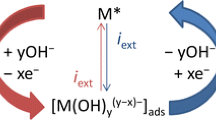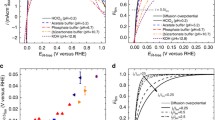Abstract.
Two unusual features of noble metal electrode surfaces, active states of the metal and their anodic oxidation products (hydrous oxides), are of increasing interest at the present time owing to the important role of such species in electrocatalysis. The extent to which the hydrous oxide reduction process overlaps with the hydrogen adsorption region was investigated for platinum in acid solution. At least three distinct hydrous oxide reduction peaks (or regions) were observed and in some cases one of these peaks commenced at ca. 0.0 V, i.e. it was almost totally within the hydrogen gas evolution region. Following repeated hydrous oxide growth and reduction, which disrupted and thus activated the metal surface, a sequence of four low-level premonolayer oxidation peaks (each of which has been noted earlier by other authors) appeared in the positive sweep. As discussed earlier for copper in base, the transitions giving rise to such peaks are assumed to be mediator generation reactions, which strongly influence electrocatalytic processes occurring on platinum at low potentials.
Similar content being viewed by others
Author information
Authors and Affiliations
Corresponding author
Additional information
Electronic Publication
Rights and permissions
About this article
Cite this article
Burke, D.L., Ahern, A.J. Overlap of the oxide and hydrogen regions of platinum electrodes in aqueous acid solution. J Solid State Electrochem 5, 553–561 (2001). https://doi.org/10.1007/s100080000185
Received:
Accepted:
Published:
Issue Date:
DOI: https://doi.org/10.1007/s100080000185




